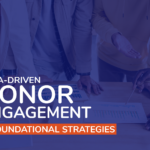How to Leverage Email as a Recruitment Tool: 4 Strategies

With approximately 344 billion emails sent per day, it’s no wonder why so many recruiters use this channel to source, engage, and secure job applicants. However, the sheer volume of emails the average candidate receives means you need to add marketing-savvy tactics to your toolkit.
This is especially true for nonprofits like yours, who often have to work harder to compete for talent with larger corporate counterparts.
In this guide, we’ll explore different ways to enhance your nonprofit’s recruitment and talent acquisition strategies with email. As we review these techniques, keep your nonprofit’s current recruitment approach in mind and consider how these strategies can help achieve your recruiting goals.
1. Use automated personalization tools.
Depending on the size of your nonprofit, you might have numerous roles open at any given time. Completely personalizing every email for each candidate can be time- and resource-consuming.
While recruitment is important for your organization’s long-term success, you should always prioritize allocating resources for mission-critical activities. Fortunately, automated tools make curating personalized email content for candidates effortless.
Automation allows your nonprofit to reach candidate groups with similar characteristics without creating a unique message from scratch for everyone. For instance, tools like Jobvite’s Recruitment Marketing Platform might improve personalization by:
- Segmenting messages to groups that share characteristics
- Creating a list of top candidates from your constituent management system (CMS) using AI
- Making custom workflows that effectively nurture the candidate based on preferences and interactions with your past messages
Also, marketing software can personalize emails by providing criteria suggestions, sorting candidates based on data stored in your recruitment tools and software, and filling out templates with candidate information.
2. Prioritize accessibility, inclusivity, and user experience (UX).
Ensuring that everyone can access and gain valuable information from your recruitment emails, regardless of ability or identity, is crucial. Optimizing your nonprofit’s approach to accessibility and UX can yield greater open rates, click-throughs, and completed applications. Here are some tips for you to get started:
- Use legible design elements. Whether it’s making your text larger, adding more negative space between text, or using high-contrast colors, make your email templates easily readable to people with visual impairments. \
- Clarify navigation and next actions. You’ll only get click-throughs, signups, and applications if you simplify the process of taking the next step for your recipients. Clearly lay out what you want the reader to accomplish and how they can do so. For instance, if you want the reader to finish an abandoned application, link to your application portal and stress that submitting it only takes a few minutes.
- Implement inclusive language and content. Reflect your nonprofit’s company culture and commitment to diversity, equity, inclusion, and belonging (DEIB) in your email content. Use visual elements with diverse subjects, avoid relying on jargon, and stress your nonprofit’s welcoming nature in your emails to encourage applications.
Using these strategies helps you highlight your unique value proposition over competitors to a wider audience. Just make sure you listen to and incorporate audience feedback so your emails continue to resonate with applicants over time.
3. Use calls-to-action.
Given the hundreds of emails your candidates might receive in a day, making your messages eye-catching and user-friendly can help your organization stand out from your competitors.
You likely already use calls-to-action (CTAs) in your fundraising materials to inspire your supporters to act, whether it’s by donating to an upcoming campaign or joining your volunteer team. Plus, digital CTAs have even more value than traditional ones since they can seamlessly link to important resources, making this tactic a no-brainer. Just as you use CTAs to drive mission support, they can be equally as effective in recruitment emails.
Fifty & Fifty’s guide to crafting CTAs suggests trying these tips for formatting your recruitment email CTAs:
- Be direct. Depending on their current place in your recruitment process, there might be several possible actions your candidates can take (i.e. completing a skills assessment during the same phase as the second round of interviews). Specify what you want your recipient to do in the clearest, most direct way possible.
- Highlight value proposition. For initial outreach emails, remember that your candidates will only apply to opportunities they think are worth their time and effort. Clearly outline your nonprofit’s mission, the unique benefits of working for your organization, and why working for a nonprofit in general is better than corporate life.
- Use facts. Overly conceptual statements could throw your readers off and distract them from completing the desired next action. Reference statistics when framing CTA content. For example, instead of saying you have high employee engagement and loyalty, you can win candidate trust by saying that you have only a 5% turnover rate over the last five years.
Remember, your CTAs should look different for different audience segments. For instance, if you’re trying to reengage a passive candidate, you’ll want to use a different tone of voice than you would for a new candidate who has never heard of your nonprofit before.
4. Pay attention to subject lines.
It takes your readers as little as two-tenths of a second to make a snap judgment about your email, leaving you practically no room for error. That’s why optimizing your subject lines is crucial for making your emails stick with your audience. Use these strategies to hook your recruitment email recipients immediately:
- Pose a question. Asking your readers a question is more likely to engage them than a simple statement. Pose a thought-provoking question in your subject line that encourages them to consider working with your nonprofit.
- Create urgency. Your readers are more likely to act swiftly if they’re facing a deadline. For instance, you could highlight that applications for a certain role close in a few days.
- Highlight benefits. Call out the benefits of working at your nonprofit, such as company culture events, which set you apart from competitors.
Ultimately, subject lines serve a similar purpose as CTAs—to attract the reader’s attention. Leverage your nonprofit’s donation and recruitment tactics for CTAs in your subject lines to resonate with your audience.
Used correctly, email can be a key component of your recruitment process. As long as you keep your nonprofit’s recruitment goals and mission at the center of your approach and leverage tools like applicant tracking systems, you can supercharge your outreach strategy with email.


